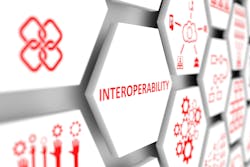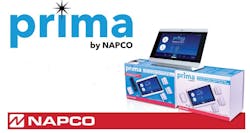Interoperability Brings New Functionality to Multi-Supplier Access Control
The need for interoperability, which enables different types of devices or technologies to communicate with one another, is certainly nothing new in our industry. It has paved the way for technological developments, while at the same time ensuring future-proof products. Most importantly, it has been a catalyst in guiding newer trends, such as AI and IoT, into maturity. As new technologies reach this crucial point where standardization is necessary for seamless integrations, we further see the need for open standards and cooperation within the market.
At Anixter, we have been testing interoperability in our Infrastructure Solutions Lab for many years, connecting devices and clients from different suppliers to our test server site to ensure that integrations and multi-supplier solutions are going to work correctly for our customers in real-world scenarios.
Due to the proprietary way that access control security components have historically been designed and manufactured, achieving interoperability between different manufacturers’ products hasn’t always been easy. It sometimes has involved developing specific device drivers or creating workarounds to get readers, panels and other peripherals to share information and communicate with a common access control management platform.
A New Interface Driving Open Access Control
As a result of the proprietary nature of the access control market, customers often have remained confined to deploying single-supplier access control systems and felt forced to buy access control panels from a particular manufacturer in order to maintain their current investments in legacy card readers, door controllers and card technology. But the industry is changing as the development of standards-based applications grow and end users and system integrators alike are recognizing the value of open standards, such as the interoperability standards created by ONVIF.
ONVIF Profile A provides an interface for ONVIF member developers to use when developing access control software and other security products. Profile A defines the requirements that govern how one Profile A application can communicate and interact with another, facilitating interoperability for multi-vendor projects.
The open device driver used in Profile A conformant access control panels allows end users to integrate control panels and management software from different manufacturers. This gives end users the ability to make choices on specific hardware for their access control systems and, even more importantly, means that if you want to install another supplier’s access control management software in the future, you don’t have to rip and replace existing access control hardware in order to do so. The common interoperability of ONVIF Profile A provides the bridge between the legacy hardware and new software if both are Profile A conformant.
Profile A covers credentialing, and from a standardization perspective, has the potential to pave the way for the future of access control. Already there is discussion about the ability for cameras to act not only as a reader in identifying a person within an access control system but to also act as the system’s control panel, and the catalyst that triggers the rest of the system to work; activating the door strike, monitoring the request to exit and door position switch, and so on.
While some manufacturers have already experimented with this concept, each has undoubtedly come at it with their own approach, utilizing few elements of standardization. Although Profile A has been established as an access control protocol, the future potential exists for it to reside in a camera and carry out the same functionalities. This enables the camera to be used as a multi-purpose device, and to not only stream video, but to communicate directly with the door controller and become an integral part of the access control system as well.
As the industry continues to improve edge devices by adding additional functions and intelligence, using common interfaces can help pave the way for faster deployments and additional innovation in these areas. This is just one example of how the vision of ONVIF, for the industry to communicate using a common interface, is being realized.
The Tipping Point Is Now
In contrast to the video surveillance market, access control technology has historically been slow to change in large part because of the high upfront costs to acquire and install a system and the longevity of the equipment — commonly between 12 and 20 years. End users and their need for open network-based infrastructures are driving recent changes in this market, as the line between physical security and IT continues to blur. Physical security systems are now often managed by IT departments and IT directors are rightfully demanding open architecture approaches (like IP networks) rather than the proprietary and sometimes duplicative design of traditional security systems.
The drive to an open architecture approach has proliferated across many related industries, and today we see lighting, HVAC and other functions residing on the network as well, offering businesses the option to minimize operating costs and to better control and monitor their facilities. This trend of hosting everything on an IP network clears a path for an Internet of Things, which in many respects is already here.
The network can already transfer pieces of data from one system or device and correlate it with other data in analytics software programs, ultimately providing usable, actionable information to end users, aggregated from several systems such as video, audio, intrusion, voice and other systems. Multiple network-based systems make things like intelligent building automation a reality, delivering cost savings, keeping people and assets safer and reducing energy requirements.
As one of the major platforms within a smart building environment, access control systems play a large role in this IoT scenario. When connected to other, seemingly disparate building systems using a common interface, this deeper interoperability enables increased productivity to the overall system. As a contributor to an intelligent building ecosystem, access control systems also serve as a repository of large amounts of data -- tracking people’s movements for real-time facility population data or facility usage based on the day’s meeting room booking schedule. The more data that is available within a system means the more quickly that adjustments can be made, further ensuring the security and efficiency of the building.
When enabled with artificial intelligence, access control and other building systems can begin to recognize patterns, anticipate events and behaviors and make proactive changes to the building environment, enabling its occupants to work more efficiently. Whether the temperature and lighting for a room are adjusted based on recognized patterns. A 10 a.m. meeting every Thursday on the fifth floor tells the system that the doors are unlocked in anticipation of this recurring event. AI allows for systems to be smarter, more effective and provide additional costs savings by further reducing the administrative burden of the system.
With so much data being fed into these management platforms, from AI technology or other more traditional sensors, a stumbling block to true interoperability still remains. To effectively be able to harvest actionable information out of the received data, it has to be readable in a common format. Data readable in only one proprietary ecosystem will jeopardize the idea of interchangeable information and further reinforce the silos that exist between the largest providers. Profile A could offer a solution for this in the future by providing users with that common interface and allow the market to continue to grow through interoperability and innovation.
Profile A: A High Return on Investment Where it matters most
Middle and smaller market manufacturers will likely find Profile A the most beneficial, as Profile A essentially levels the playing field between large and small manufacturers, eliminating the need for proprietary protocols between suppliers for communications between different components of a system. End users can, for example, choose specialized, high-end access controllers and panels from one manufacturer to use with Profile A conformant access control software that is perhaps lesser known but that provides what the end user needs when it comes to management and reporting.
Another segment of the security market that will benefit from Profile A is the middle-market business that is growing and acquiring other smaller companies. As manufacturers continue to adopt Profile A into their products, Profile A conformant access control componentry will mean that a business doesn’t have to rip and replace the Profile A conformant access control devices in the facilities that they’ve acquired. Instead, they can deploy and use their own preferred management software in the newly acquired facilities using existing hardware. This can offer huge cost savings for businesses.
It’s also important to note that Profile A and other access control standards, such as the Security Industry Association’s Open Supervised Device Protocol (OSDP) that allows access control hardware, such as card readers and control panels, to interface with each other, are not competing standards but are complementary. ONVIF Profile A and OSDP can coexist within the same access control ecosystem and can both provide benefits. This synergy between ONVIF Profile A and other standard interfaces allow end users to implement technology driven by their specific needs, rather than by a single standard or proprietary brand approach.
A Long-Term Commitment to Access Control Interoperability
With the development and release of Profile A, ONVIF is making a long-term commitment to open access control systems in particular. The development of Profile A took two years and the work of many ONVIF member company representatives from all over the world to develop a standard that can take the physical security market into the next decade.
One thing that ONVIF and Anixter have in common is the shared view that standards are created to be tools that let customers make educated decisions and still provide them with the freedom to choose the hardware and software of their choice, regardless of manufacturer.
About ONVIF
ONVIF (Open Network Video Interface Forum) was founded as a technical alliance by Axis Communications, Sony and Bosch Security and Safety Systems and today have nearly 10,000 conformant products and a member base spanning six continents and 39 countries. ONVIF specifications have been adopted by such global standards bodies as the International Electrotechnical Commission (IEC) and Cenelec and are becoming increasingly applicable in growing security and connectivity environments such as Safe City initiatives, IoT applications and intelligent building automation. To learn more about Profile A or any of the ONVIF Profiles, visit www.onvif.org.
About the Author: Bob Dolan is on the ONVIF Technical Services Committee and is Director of Technology Security Solutions at Anixter. He brings with him over 29 years of sales, management, and technical experience in the physical security industry. After working with end-users and integrators for many years, Bob earned his RCDD (Registered Communication Distribution Designer) certification from BICSI (Building Industry Consulting Standards International) in 2009 and his CPP (Certified Protection Professional) from ASIS in 2012.






